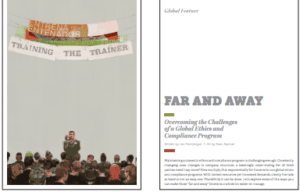Maintaining a domestic ethics and compliance program is challenging enough. Constantly changing laws, changes in company structure, a seemingly never-ending list of third parties; need I say more? Now multiply that exponentially for those who run global ethics and compliance programs. With limited resources yet increased demands, clearly the task at hand is not an easy one. Thankfully it can be done. Let’s explore some of the ways you can make those “far and away” locations a whole lot easier to manage.
Click here to review the full article
It’s not as if maintaining a successful compliance program is simply a “good” thing to do. Each and every day the headlines are littered with tales of corruption, fraud and corporate scandal; the kind of stories that can prove devastating for an organization. As a result, organizations are making huge investments in compliance, ethics, developing programs, improving risk assessment systems, implementing training and communication plans, setting new standards and nurturing corporate culture. Companies want to maintain the reputation necessary to compete and ultimately meet the needs of their stakeholders including investors, customers, business partners and local communities, all of whom are increasingly expecting companies to operate with integrity.
Quite simply, a successful compliance and ethics program is a “must” and not simply for the heavily regulated industries such as banking and healthcare. To get the ball rolling, let’s take a journey through each of the hallmarks of a complete ethics and compliance program to determine what needs to be done to effectively implement it around the globe. These hallmarks include program resources and structure, written standards, training and communication, monitoring and auditing, enforcement and discipline and ethical culture.
Program Resources and Structure
More often than not, one person maintains responsibility for the compliance and ethics program, usually a general counsel or chief ethics and compliance officer. Now, what if the company operates in 30 countries across five continents? The expanded footprint adds a tremendous amount of responsibility and clearly s/he will need some help. Organizations can look to maximize limited compliance and legal resources by obtaining the assistance of employees embedded within regions or business units who may formally serve as ethics and compliance liaisons.
These individuals can function as local points of contact for compliance related needs and can offer two huge benefits; assistance with program initiatives and a feedback loop to maintain awareness of important issues at all times. Taking this approach can dramatically increase the impact of your ethics and compliance programs. It is important to carefully nurture the relationship with ethics and compliance liaisons. These employees have full-time jobs and a relatively small amount of time to devote to compliance related activities. In an effort to promote success, make sure the commitment you seek is manageable on their end as well.
Download and read the full article here.
About the Author:
Les Prendergast is a former VP and Managing Editor at Ethisphere. His primary areas of expertise include overall compliance program assessment, culture and knowledge assessment, risk assessment, training and communication planning, and benchmarking.




